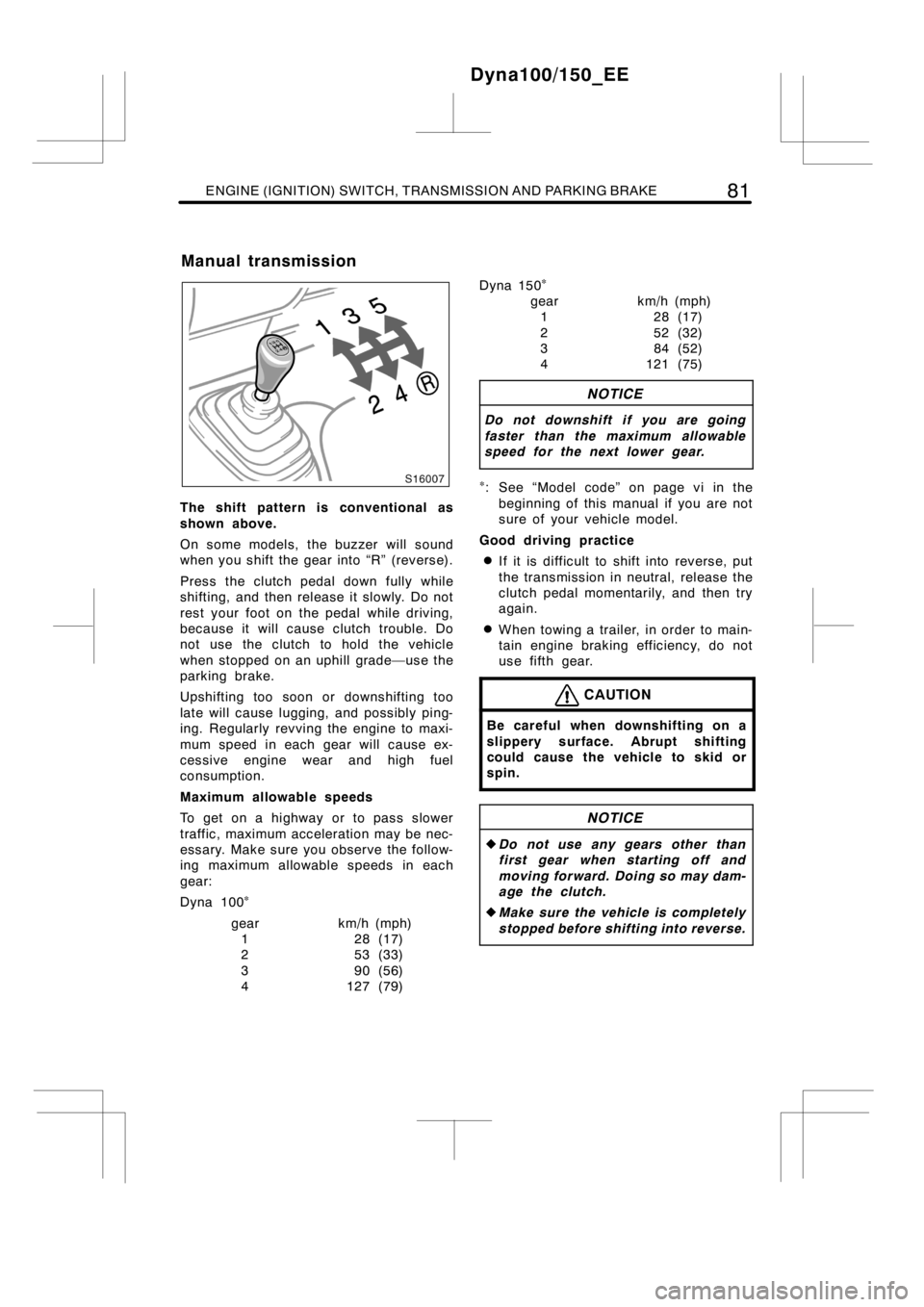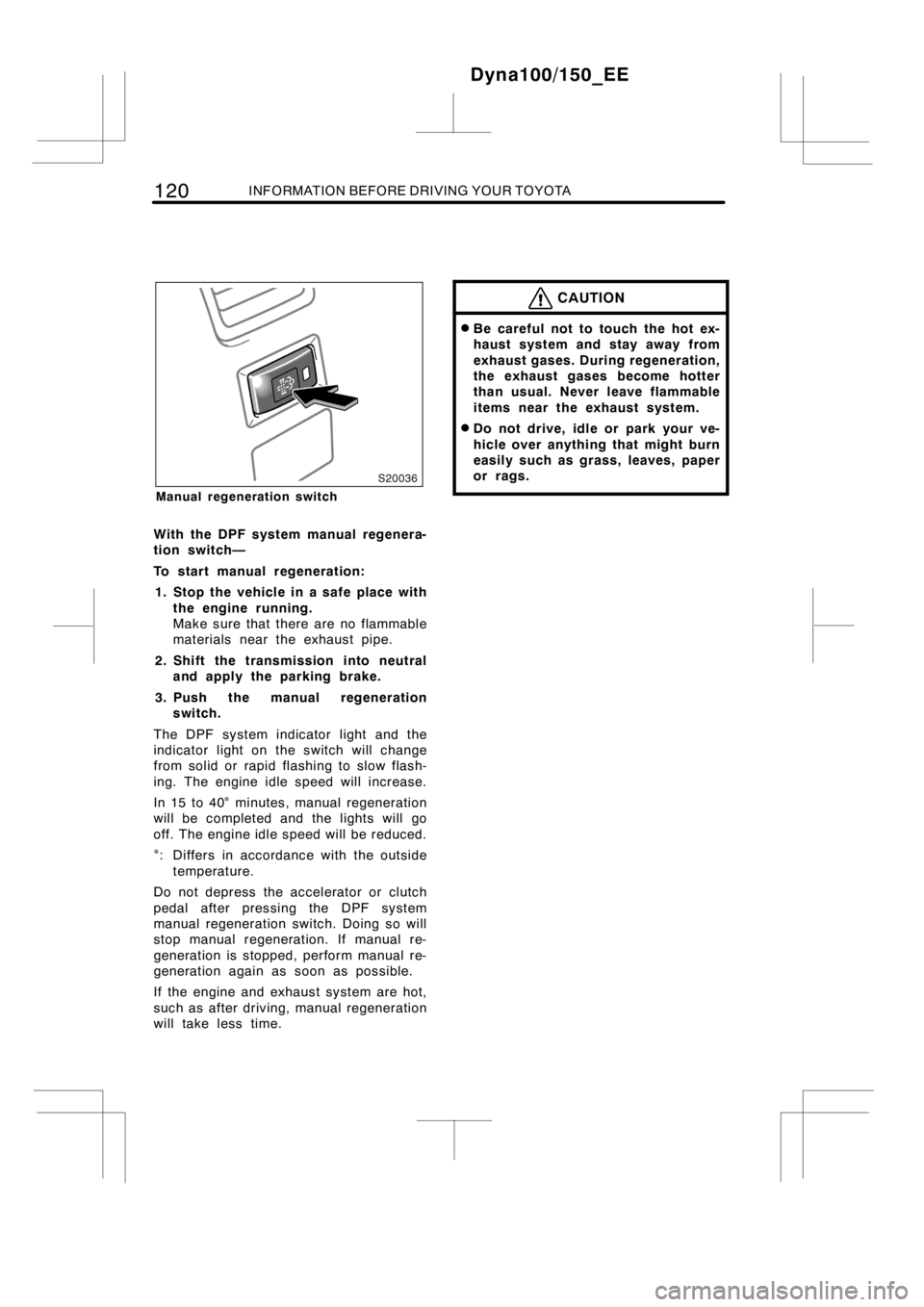Page 8 of 240
2OVERVIEW OF INSTRUMENTS AND CONTROLS
1. Side defroster outlets
2. Side vents
3. Instrument cluster
4. Center vents
5. Interior light
6. Glove box7. Power window switches
8. Parking brake lever
9. Manual transmission gear shift lever
10. Window lock switch
11. Brake fluid reservoir cover
Dyna100/150_EE
Instrument panel overview
"Left−hand drive vehicles
Page 10 of 240
4OVERVIEW OF INSTRUMENTS AND CONTROLS
1. Side defroster outlets
2. Glove box
3. Interior light
4. Center vents
5. Instrument cluster
6. Side vents7. Brake fluid reservoir cover
8. Window lock switch
9. Power window switches
10. Manual transmission gear shift lever
11. Parking brake lever
Dyna100/150_EE
"Right−hand drive vehicles
Page 24 of 240
18KEYS AND DOORS
Before tilting the cab, observe the fol-
lowing.
1. Park the vehicle on a level ground.
2. Set the parking brake firmly.
3. Put the transmission in neutral.
4. Stop the engine.
5. Remove or secure all the loose items
in the vehicle.
6. Close the doors.
CAUTION
Make sure that no one is around and
in the cab.
NOTICE
Make sure that there is no interfering
object on and in front of the cab.
�: See “Model code” on page vi in the
beginning of this manual if you are not
sure of your vehicle model.
Handle latch lever
Cab lock
handle
1. Pull the cab lock handle up while
holding the handle latch lever up,
and the cab will spring up slightly.
Dyna100/150_EE
Tilt cab—
(single cab models�)—Tilting the cab
Page 85 of 240
ENGINE (IGNITION) SWITCH, TRANSMISSION AND PARKING BRAKE79
Section 1−6
OPERATION OF INSTRUMENTS AND
CONTROLS
Engine (ignition) switch, Transmission and Parking
brake
DEngine (ignition) switch 80.............................
DManual transmission 81................................
DParking brake 82......................................
Dyna100/150_EE
Page 87 of 240

ENGINE (IGNITION) SWITCH, TRANSMISSION AND PARKING BRAKE81
The shift pattern is conventional as
shown above.
On some models, the buzzer will sound
when you shift the gear into “R” (reverse).
Press the clutch pedal down fully while
shifting, and then release it slowly. Do not
rest your foot on the pedal while driving,
because it will cause clutch trouble. Do
not use the clutch to hold the vehicle
when stopped on an uphill grade—use the
parking brake.
Upshifting too soon or downshifting too
late will cause lugging, and possibly ping-
ing. Regularly revving the engine to maxi-
mum speed in each gear will cause ex-
cessive engine wear and high fuel
consumption.
Maximum allowable speeds
To get on a highway or to pass slower
traffic, maximum acceleration may be nec-
essary. Make sure you observe the follow-
ing maximum allowable speeds in each
gear:
Dyna 100
�
gear km/h (mph)
1 28 (17)
2 53 (33)
3 90 (56)
4 127 (79)Dyna 150
�
gear km/h (mph)
1 28 (17)
2 52 (32)
3 84 (52)
4 121 (75)
NOTICE
Do not downshift if you are going
faster than the maximum allowable
speed for the next lower gear.
�: See “Model code” on page vi in the
beginning of this manual if you are not
sure of your vehicle model.
Good driving practice
DIf it is difficult to shift into reverse, put
the transmission in neutral, release the
clutch pedal momentarily, and then try
again.
DWhen towing a trailer, in order to main-
tain engine braking efficiency, do not
use fifth gear.
CAUTION
Be careful when downshifting on a
slippery surface. Abrupt shifting
could cause the vehicle to skid or
spin.
NOTICE
zDo not use any gears other than
first gear when starting off and
moving forward. Doing so may dam-
age the clutch.
zMake sure the vehicle is completely
stopped before shifting into reverse.
Dyna100/150_EE
Manual transmission
Page 122 of 240

11 6INFORMATION BEFORE DRIVING YOUR TOYOTA
Drive gently and avoid high speeds.
Your vehicle does not need an elaborate
break−in. But following a few simple tips
for the first 1000 km (600 miles) can add
to the future economy and long life of
your vehicle:
DAvoid full throttle acceleration when
starting and driving.
DAvoid racing the engine.
DTry to avoid hard stops during the first
300 km (200 miles).
DDo not drive slowly with the manual
transmission in a high gear.
DDo not drive for a long time at any
single speed, either fast or slow.
DDo not tow a trailer during the first 800
km (500 miles).Selecting the proper fuel is essential
for satisfactory engine performance.
Engine damage caused by use of improp-
er fuels is not covered under Toyota’s new
vehicle warranty.
NOTICE
zDo not use improper fuels. If im-
proper fuels are used the engine
will be damaged.
zDo not use a fuel that contains
more than 50 ppm of sulfur. Use of
such a high sulfur fuel may damage
the engine.
zEU area: FAME (Fatty Acid Methyl
Ester) fuel sold under names such
as “B30” or “B100” and fuel
containing a large amount of FAME
should not be used. The use of
these fuels will damage the ve-
hicle’s fuel system. In case of any
doubt, ask any authorized Toyota
dealer or repairer, or another duly
qualified and equipped professional.
zExcept EU area: FAME (Fatty Acid
Methyl Ester) fuel sold under names
such as “B30” or “B100” and fuel
containing a large amount of FAME
should not be used. Your vehicle
can use diesel mixed with 5% max
biodiesel FAME (B5). The use of
fuel with more than 5% FAME con-
tent (B5) will damage the vehicle’s
fuel system. You must ensure that
refueling is carried out only from a
source where fuel specification and
quality can be guaranteed. In case
of any doubt, ask any authorized
Toyota dealer or repairer, or anoth-
er duly qualified and equipped pro-
fessional.
Dyna100/150_EE
Break−in period Fuel
Page 126 of 240

120INFORMATION BEFORE DRIVING YOUR TOYOTA
Manual regeneration switch
With the DPF system manual regenera-
tion switch—
To start manual regeneration:
1. Stop the vehicle in a safe place with
the engine running.
Make sure that there are no flammable
materials near the exhaust pipe.
2. Shift the transmission into neutral
and apply the parking brake.
3. Push the manual regeneration
switch.
The DPF system indicator light and the
indicator light on the switch will change
from solid or rapid flashing to slow flash-
ing. The engine idle speed will increase.
In 15 to 40
�minutes, manual regeneration
will be completed and the lights will go
off. The engine idle speed will be reduced.
�: Differs in accordance with the outside
temperature.
Do not depress the accelerator or clutch
pedal after pressing the DPFsystem
manual regeneration switch. Doing so will
stop manual regeneration. If manual re-
generation is stopped, perform manual re-
generation again as soon as possible.
If the engine and exhaustsystem are hot,
such as after driving, manual regeneration
will take less time.
CAUTION
DBe careful not to touch the hot ex-
haust system and stay away from
exhaust gases. During regeneration,
the exhaust gases become hotter
than usual. Never leave flammable
items near the exhaust system.
DDo not drive, idle or park your ve-
hicle over anything that might burn
easily such as grass, leaves, paper
or rags.
Dyna100/150_EE
Page 231 of 240

SPECIFICATIONS225
MANUAL TRANSMISSION
Oil capacity, L (qt., Imp. qt.):
Dyna 100
�2.6 (2.7, 2.3)
Dyna 150�2.4 (2.5, 2.1)
Oil type:
Gear oil API GL−4orGL−5
Recommended oil viscosity:
SAE 75W−90
�: See “Model code” on page vi in the
beginning of this manual if you are not
sure of your vehicle model.
DIFFERENTIAL
Oil capacity, L (qt., Imp. qt.):
Dyna 100
�2.30 (2.43, 2.02)
Dyna 150�3.45 (3.65, 3.04)
Your Toyota vehicle is filled with “Toyota
Genuine Differential Gear Oil” at the
factory. Toyota recommends the use of
approved “Toyota Genuine Motor Oil”.
Another motor oil of matching quality can
also be used.
Oil type:
Standard differential
Hypoid gear oil API GL−5
Limited slip differential
Hypoid gear oil LSD API GL−5
Recommended oil viscosity:
Above−18_C(0_F)
SAE 90
Below−18_C(0_F)
SAE 80W or 80W−90
�: See “Model code” on page vi in the
beginning of this manual if you are not
sure of your vehicle model.
Please contact any authorized Toyota
dealer or repairer, or another duly quali-
fied and equipped professional, for further
details.CHASSIS LUBRICATION
Wheel bearings:
Lithium base wheel bearing grease,
NLGI No.2
Ball joints:
Molybdenum−disulfide lithium base chas-
sis grease, NLGI No.1 or No.2
Propeller shafts:
Lithium base chassis grease, NLGI No.2
BRAKES
Minimum pedal clearance when depressed
with the force of 490 N (50 kgf, 110 lbf)
with the engine running, mm (in.):
Dyna 100
�59 (2.3)
Dyna 150�51 (2.0)
Pedal free play, mm (in.):
1—6 (0.04—0.24)
Parking brake adjustment when pulled with
the force of 245 N (25 kgf, 55 lbf):
Dyna 100
�4—6 clicks
Dyna 150�6—8 clicks
Fluid type:
SAE J1703 or FMVSS No.116 DOT 3
�: See “Model code” on page vi in the
beginning of this manual if you are not
sure of your vehicle model.
STEERING
Wheel free play:
Less than 40 mm (1.6 in.)
Power steering fluid type:
Automatic transmission fluid DEXRONrII
or III
Dyna100/150_EE